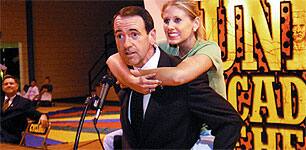Life Extension Magazine®
In 2003, at the age of 47, Arkansas Governor Mike Huckabee was diagnosed with type II diabetes. His physician warned him that he probably had—at most—another 10 years to live. Heeding that warning, Gov. Huckabee underwent a dramatic program of diet, exercise, and supplements, losing more than 100 pounds and completely eradicating his diabetes and related health risks. Now, transformed by this life-saving experience, Gov. Huckabee is aggressively working to change the health of Americans through targeted initiatives that emphasize prevention. Gov. Huckabee is the rare high-ranking government official who believes it is possible to achieve optimal health and wellness while reducing and even eliminating degenerative disease. He is aware that by preventing chronic disease, not only will Americans live longer, but the federal and state governments can save billions of dollars that would otherwise be spent treating killer diseases such as diabetes, heart disease, and cancer, just to name a few. In short, the governor’s emphasis on prevention could help the country turn the corner away from treating disease to achieving optimal health and longevity. He is one of the first public officials to commit himself and his administration to changing the health of Americans instead of throwing medicine at them after they become sick. He has targeted government dollars to educate the public and actively fight adult and childhood obesity, smoking, and other health problems. His initiatives in areas such as diabetes intervention have shown impressive results, producing significant reductions in program participants’ blood sugar levels, depression symptoms, and blood pressure readings. His ambitious, state-level initiatives such as Healthy Arkansas have made the state a model for improving the health of its citizens. Now, as chairman of the National Governors Association, Gov. Huckabee is taking his campaign to the national level. His goal is nothing less than achieving a complete transformation of the contemporary American diet and lifestyle, which not only jeopardize the health of tens of millions of American adults and children, but also threaten to overwhelm the nation’s health care system. When asked by Life Extension how much he thought America’s $2 trillion-a-year health care budget could be trimmed if everyone were to follow his program, Gov. Huckabee replied, “the amount could be staggering, since most disease in the United States is chronic and related to lifestyle choices.”
A Nationwide Crusade for HealthLast July, Gov. Huckabee became chairman of the National Governors Association (NGA). In September, at the National Press Club in Washington, DC, the governor unveiled his NGA Chairman’s Initiative: Healthy America: Wellness Where We Live, Work and Learn. Building on the success of the Healthy Arkansas program, this yearlong initiative will raise awareness of the urgent need for Americans of all ages to lead healthier, more active lives. More than a quarter of American adults are physically inactive, and 65% are overweight. Poor diet and lack of physical activity contribute to the premature deaths of nearly 600,000 Americans each year. Moreover, millions of Americans are not even aware that many chronic diseases—such as diabetes, arthritis, and stroke—are largely preventable. “We’re facing a health crisis in this country,” says Gov. Huckabee. “A lack of action isn’t an option. For too long, we’ve focused our resources on treating diseases rather than preventing them.” Gov. Huckabee believes states can play in an important role in encouraging long-term, health-promoting behaviors in our communities, workplaces, and schools. For example, family-focused education campaigns can encourage active living and healthy eating. As Gov. Huckabee told Life Extension, “Good health habits are more ‘caught’ than ‘taught.’ Kids aren’t going to eat better if their parents don’t.” Other examples include state grants supporting the development of supermarkets and fresh food retailers in underserved areas, support for businesses interested in providing strategies and incentives to improve employee wellness and lower health insurance premiums, and helping schools offer healthy eating alternatives, physical education, and innovative programs such as measuring students’ Body Mass Index (BMI). In addition to Arkansas, many states have now launched similar programs to begin building a healthier America. In Maine, for example, the Healthy Maine Partnership has helped tighten tobacco-free school regulations and ban the sale of soft drinks and candy during school hours. With nearly a quarter of its high school students either overweight or at risk of becoming overweight, Michigan has mandated a minimum of 150 minutes of physical education per week in its elementary schools and 225 minutes weekly in its middle and high schools.
An Overdue Wake-Up CallMike Huckabee was a heavyweight long before he entered the political ring in Arkansas. Gov. Huckabee was raised a Southern Baptist by working-class parents in the “land of deep fried,” a culture in which food—usually fried, and lots of it—was offered as a reward in good times and a consolation in bad times. Not surprisingly, he developed a weight problem early on. Although he had tried many diets and occasionally had lost weight during various periods of his life, the same poor habits that had led to weight gain in the first place would eventually creep back, as would the pounds lost. The governor’s excessive girth had long been a source of personal embarrassment, mostly in mundane ways such as the daily struggle to fit into an airline seat or a restaurant booth. Occasionally, his weight problem had more resounding effects, including one he describes in his book as “like a scene from a Three Stooges film.” At a meeting of his 53-member cabinet in the historic, ornate Governor’s Conference Room at the Arkansas State Capitol, Gov. Huckabee commenced the gathering by attempting to sit in—and promptly shattering—an antique chair brought in especially for the occasion. As his cabinet silently looked on in a mixture of concern and barely suppressed amusement, the always good-humored governor managed to quip, “Boy, they sure don’t build ’em like they used to!” But as he notes in his book, “Deep down, I knew it wasn’t the chair that needed rebuilding—it was me that needed a major overhaul.”
In 2002, embarrassment turned to anger and alarm, when Gov. Huckabee visited his doctor complaining of numbness in his arm, only to learn that he had type II diabetes and a blood sugar level that was off the charts. Although the news was hardly surprising—the governor’s weight had soared to about 280 pounds, and he had two parents and two grandparents who were type II diabetics—his anger came from knowing this diagnosis was not only preventable, but potentially tragic in its consequences: “I knew that this disease diagnosed at the age of 47 would probably mean a very strong likelihood of heart attack, stroke, loss of sight, or loss of limb, as well as a much-earlier-than-expected death.” In the next year, however, things only got worse. By the spring of 2003, Gov. Huckabee began experiencing chest pains and other symptoms characteristic of heart disease. Suspecting blocked arteries, he underwent a heart catheterization. Although the results came back negative, the governor’s cardiologist pronounced him horribly out of shape and said that without changes in diet and exercise, heart disease and other serious health problems were inevitable. This prognosis was confirmed by Gov. Huckabee’s primary-care physician, Dr. Charles Berg, who informed him that without major lifestyle changes, he had less than a decade left to live. Shortly thereafter, Gov. Huckabee’s growing desperation and desire to address his weight problem were even further intensified by the death of a close friend and political associate, former Arkansas governor Frank White. Less than a week after visiting Gov. Huckabee and describing his plans to travel during his retirement years, former governor White dropped dead of a heart attack at the age of 69.
Getting with the ProgramGov. Huckabee knew he wanted to get healthy, but simply had no idea how to succeed. His break came when he was approached by a close advisor and cabinet member about a weight-loss program offered at the University of Arkansas for Medical Sciences (UAMS). Led by Dr. Philip Kern, a renowned endocrinologist whose research specialty is metabolism, the UAMS program approaches weight loss in the context of permanent lifestyle changes, anchored by healthy eating habits and balanced nutrition.
In the program’s first phase, patients are put on a largely liquid diet of prepared soups and nutritional supplements. The idea is not only to eliminate sugary and high-glycemic-index foods from one’s diet, but also to effect a dramatic change away from typical eating habits. According to Gov. Huckabee, “It worked for me because I didn’t have to think, plan, or fret about what I could or couldn’t eat. I needed that intense ‘breakaway’ from having to choose my food until I changed me enough to make smart choices.” Having been broken of their former eating habits and educated about more healthful food choices, patients on the UAMS program eventually return to eating solid foods. While the UAMS program was a big part of his success, Gov. Huckabee is quick to point out that there is no “secret” to weight loss, nor is he partial to one type of diet over another. After all, he notes, “weight loss comes back to this simple truth—fewer calories in (consumption) and more calories out (exercise).” In fact, he writes, “a focus on weight loss will probably lead to failure. Instead, your focus needs to be on actual health and fitness. With permanent health and fitness, the weight will take care of itself . . . My experience is that most people fail not because their method fails them, but because their motivation fails them. The challenge is not so much to change your actions on a temporary basis but rather to change your attitudes on a permanent basis.” On the Path to FitnessAs Gov. Huckabee began to change his diet, he also embarked on a program of regular exercise, something he had disdained all his life. He started small, going on early-morning walks with his black Labrador, Jet. At the outset, just 12 minutes of walking left him virtually breathless. Yet he persisted with the program, gradually building strength. He also began to ride a stationary bike and work out on a weight machine several days a week. One day, several months after beginning his exercise program, he spontaneously began running, an experience he likens in his book to “the scene from Forrest Gump when Forrest was being chased by a group of bullies and, as he started running, his leg braces fall off. I was being chased by a lifetime of bad habits and voices telling me I couldn’t, but that day, I found out I could!” About a year after beginning the program—and about 100 pounds lighter than when he started—he surprised himself by running in the Firecracker 5K race in Little Rock, a feeling of exhilaration that he likens to “winning the Super Bowl.” Additional races followed. Remarkably, last spring, just two years after starting his diet and exercise program, Gov. Huckabee completed the 26.2-mile Little Rock Marathon. When Life Extension asked the governor to compare the before-and-after effects of his diet and exercise program, he replied, “I have nothing to compare it to—I’m doing things I couldn’t do when I was 17!” Today, his exercise regimen consists of getting up each morning at 4:30, warming up by walking a mile or so with his dog, and running or (on non-running days) cross training, followed by 30 minutes of riding a stationary bike while reading the morning paper. He also lifts weights several times a week. The governor’s diet has undergone an equally drastic change. His former sugar- and fat-laden diet—which he described as “fried foods, lots of potatoes, gravy, ice cream, just about anything, especially snack foods and chips”—has been replaced by one emphasizing fruits and vegetables, lean proteins, whole grains, and nuts. He strictly avoids refined sugar, trans fats, and highly processed foods. He also supplements with a daily multi-vitamin, folic acid, and garlic tablets. Once the “poster child” for everything that is wrong with America’s state of health, today Gov. Huckabee is the picture of health. He long ago discontinued taking medication for his diabetes, which has been completely eliminated. When asked by Life Extension about the status of health markers such as blood sugar, blood pressure, and cholesterol, the governor replied, “I have the body chemistry of a teenager—all are in the exceptional range.” Gov. Huckabee’s personal odyssey has not only informed his views about the sorry state of health and health care in his native Arkansas and in America generally, but has also emboldened him to take a leadership role in changing a culture focused on treating disease to one focused on creating health and wellness. As he notes in his book, “I have embarked on a mission to challenge the faulty thinking of our current system that could result in a complete change in the paradigm of health care in America.” |
|||||||||||||
Healthy Arkansas InitiativeEven before undergoing his own personal health transformation, Gov. Huckabee had established himself as a leader in improving the quality of health care for Arkansas natives. He received national recognition for creating the ARKids First program, which provided health insurance to tens of thousands of children who previously had no access to health insurance. The governor also was instrumental in the passage of a ballot initiative in 2000 requiring that all of the state’s tobacco settlement money be devoted to improving the health of Arkansans. In May 2004, Gov. Huckabee launched his most ambitious program to date: Healthy Arkansas (www.arkansas.gov/ha), an initiative to create incentives and offer information to help Arkansans eat healthier, exercise more, and stop smoking—in short, to transform one of the nation’s unhealthiest states into one of the healthiest. According to a 2001 report from the federal Centers for Disease Control and Prevention (CDC), Arkansas ranked first among the 50 states in stroke mortality, sixth in deaths due to lung cancer, eight in mortality due to heart disease, and ninth in cancer mortality.
These frightening statistics were a direct reflection of the prevalence of obesity, tobacco use, and physical inactivity among Arkansans. The 2002 Behavioral Risk Factor Surveillance Study found that 37% of Arkansas adults were overweight, 24% were obese, 27% engaged in no exercise or leisure-time physical activity, and 26% were current smokers. In the previous decade, the state’s number of obese adults had climbed 80%. Health indicators among Arkansas youth were equally worrisome. The Youth Risk Behavior Survey of 2001 found that 14% of Arkansas youth were overweight, 34% did not get enough regular exercise, and 19% were current smokers. According to CDC projections, nearly 10,000 Arkansas youth were likely to die from smoking-related causes, a figure 11% above the national average. “We must convince Arkansans that the key to real change is a behavioral change,” Gov. Huckabee noted in announcing the initiative. “We eat the wrong foods. We smoke too much. We don’t exercise enough. If a person maintains a normal body weight, exercises at least three times each week, and doesn’t use tobacco, that person will live an average of 13 years longer than he or she would live otherwise.” Using existing resources and funding sources, Healthy Arkansas seeks to achieve the following goals by January 2007:
Diabetes Education Improves Health, Controls CostsNowhere has Gov. Huckabee and the state of Arkansas moved more aggressively than in the area of diabetes intervention. The state’s Diabetes Disease Management Program is a unique public-private partnership that brings together agencies and organizations as diverse as Eli Lilly and Company, the Arkansas Department of Human Services, and the Arkansas Department of Health’s Diabetes Control and Prevention Program. Working with Eli Lilly, which supplies diabetes medications to the state, Arkansas has opened 24 diabetes education centers around the state for residents who want to learn more about managing their diabetes. The program emphasizes face-to-face consultation between trained diabetes educators and patients. Patients are taught how to make positive lifestyle changes, with specific information provided on topics ranging from diabetes medications to the importance of exercise, eating healthy, and effectively managing stress. For Arkansas and other states, controlling the rising tide of type II diabetes is more than a matter of physical health—the state’s fiscal health is equally at stake. The US Department of Health and Human Services reports that someone in the US is diagnosed with diabetes every 25 seconds. Direct medical costs attributable to the disease are estimated at $130 billion. And according to the CDC, an astonishing one in three US children born in the year 2000 will develop diabetes without proper intervention. In Arkansas, where the prevalence of diabetes climbed 35% from 1993 to 2002, controlling diabetes is essential to reining in explosive growth in the state’s Medicaid budget. Medicaid insures nearly one quarter of the state’s population. Arkansas’ annual Medicaid budget now tops $3 billion—up from approximately $600,000 just 10 years ago—and is growing at an annual rate of about 9%. “We must rein in the cost of this program,” Gov. Huckabee said in announcing the Healthy Arkansas initiative. “Five percent of the Medicaid cases are taking 50% of the Medicaid budget. We have to change people’s behavior. Otherwise, the growth of Medicaid will continue to erode the resources we have for public education, public safety, and other parts of the state budget.”
Pilot Program Shows Promising ResultsInitial results involving a sample of Arkansas Medicaid patients with diabetes demonstrate the benefits of the state’s aggressive education and intervention approach. This trial study tracked 212 Medicaid recipients with diabetes from 60 counties. The study subjects were referred to certified diabetes education centers throughout the state, where they underwent an hour-long initial assessment of individual training needs—more than they likely have ever received from their personal physician. Over the next year, each participant received 12 hours of group or individual instruction on nutrition and diabetes self-management. Working with nurses, registered dietitians, and diabetes educators, the program participants learned how to monitor their blood glucose levels, were taught how to self-examine eyes, feet, and skin for diabetes-related circulatory problems, received counseling on the importance of exercise and stress management, and were shown how to make healthy food choices and adopt better cooking habits. Participants were even taken on a “field trip” to a local grocery store, where educators demonstrated the importance of understanding food labeling. Initial data from the study found a 27% increase in the number of subjects whose average blood sugar level met American Diabetes Association (ADA) recommendations. The number of patients who screened positive for symptoms of depression dropped 10%, while the number exceeding recommended blood pressure levels fell 7%. The frequency of self-monitoring of blood glucose levels rose 21%, while daily foot exams increased by 8%. Moreover, over one year, mean HbA1c—a critical marker of blood glucose control—declined 0.4 percentage points among subjects who completed the program. “Studies show that tight blood glucose control, sustained over time (as measured by HbA1c), slows the development of diabetes-related complications, such as eye, kidney, and nerve diseases that can lead to amputations,” according to Carol Hendrickson of the ADA’s Leadership Council. “In fact, research has shown that for every 1 percentage-point drop in HbA1c (e.g., from 9% to 8%), there is a 35% reduction in the risk for diabetes-related complications.” The Arkansas researchers believe that the state’s diabetes intervention program can reduce resource utilization among Medicaid recipients within one year and is likely to improve diabetes outcomes over time at little or no cost. The program’s success has prompted the state Department of Health to open an additional 18 ADA-certified disease management sites, targeting counties with the highest number of diabetes patients. “We learned a lot from this effort,” Gov. Huckabee noted. “We discovered that when we can identify those who suffer from diabetes and then provide them with free, close-to-home help, it makes a huge difference in their lives, the Medicaid program, and the state’s economy.”
Rewarding Healthy BehaviorWhile Healthy Arkansas seeks to reduce obesity, tobacco use, and physical inactivity among all Arkansans, included in this broad initiative are several programs that specifically target Medicaid recipients and state employees. Shortly after unveiling Healthy Arkansas, for example, Gov. Huckabee announced that the state would implement a series of steps to reduce smoking among state employees and Medicaid recipients. A policy directive ordered state agencies to ban smoking within 25 feet of the entrances to state buildings. Each state agency was directed to study a potential smoking ban on all state property. Both the state Health Department and the University of Arkansas for Medical Sciences implemented complete smoking bans on their property.
Rather than simply banning or discouraging smoking, however, the governor has implemented innovative measures to encourage healthy behavior. Although traditional health insurance policies do not generally cover services that help people quit smoking, Gov. Huckabee asked the Arkansas State and Public School Life and Health Insurance Board to amend state employee health insurance policies to cover nicotine patches and similar smoking-cessation aids. The Board oversees health insurance policies covering more than 63,000 state employees and their dependents, as well as nearly 71,000 public school teachers and their dependents. He also asked the Board to explore financial and other incentives that could be offered to state employees who voluntarily participate in programs that reward healthy behavior. Today, state employees receive nutrition counseling, “walking breaks” instead of smoking breaks, and discounted health insurance premiums if they agree to undergo a voluntary personal health-risk assessment. Gov. Huckabee extended similar incentives to the state’s nearly 600,000 Medicaid recipients, directing the Department of Human Services to expand Medicaid coverage to pay for nicotine patches and similar smoking-cessation tools. According to a recent national study, 26% of all adult Medicaid recipients in Arkansas used tobacco products in 2002, costing the state an estimated $540 million. Nationally, approximately one of every seven dollars spent on Medicaid is related to tobacco use. “If we’re going to urge smokers to quit, we must support their efforts by doing things such as paying for nicotine patches,” says Gov. Huckabee. “It’s not fair to ask people to help if their health insurance plans won’t cover their cessation efforts. We must make such tools available to state employees and to those receiving Medicaid benefits. “Those who don’t smoke cost health plans less money. Allocating funds for cessation programs thus saves us money in the long run.”
From Healthy Arkansas to Healthy America
Gov. Huckabee hopes to see other states—and America itself—follow Arkansas’ lead in creating incentives for healthy behavior. “Ultimately, it is my hope and goal that Healthy Arkansas will spread like a highly contagious but benevolent virus that could become the genesis of ‘Healthy America,’” he writes. “I’d like to see all 50 states find creative ways to reward positive behavior rather than continually pay absurd amounts of money for the catastrophic results of bad behavior and health.” |












